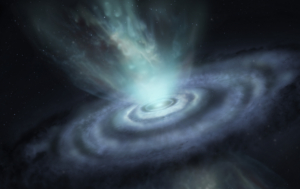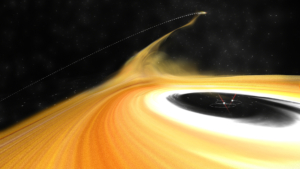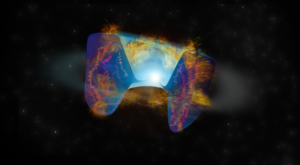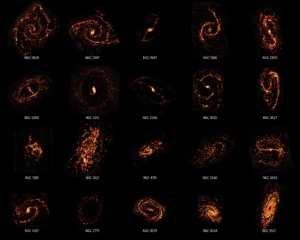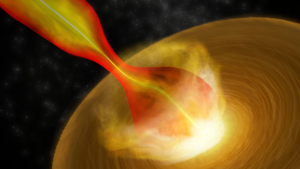Scientists studying V Hydrae (V Hya) have witnessed the star’s mysterious death throes in unprecedented detail. Using the Atacama Large Millimeter/submillimeter Array (ALMA) and data from the Hubble Space Telescope (HST), the team discovered six slowly-expanding rings and two hourglass-shaped structures caused by the high-speed ejection of matter out into space.
ALMA Catches “Intruder” Redhanded in Rarely Detected Stellar Flyby Event
Scientists using the Atacama Large Millimeter/submillimeter Array (ALMA) and the Karl G. Jansky Very Large Array (VLA) made a rare detection of a likely stellar flyby event in the Z Canis Majoris (Z CMa) star system. An intruder—not bound to the system—object came in close proximity to and interacted with the environment surrounding the binary protostar, causing the formation of chaotic, stretched-out streams of dust and gas in the disk surrounding it.
Stellar Collision Triggers Supernova Explosion
The Very Large Array Sky Survey gave astronomers the first clue that ultimately revealed a dramatic story — the remnant of a star that exploded long ago had plunged into the core of its companion star causing it, too, to explode as a supernova.
New Study Reveals Previously Unseen Star Formation in Milky Way
A new survey of our home galaxy, the Milky Way, combines the capabilities of the Very Large Array and the Effelsberg telescope in Germany to provide astronomers with valuable new insights into how stars much more massive than the Sun are formed.
Cosmic Cartographers Map Nearby Universe Revealing the Diversity of Star-Forming Galaxies
A team of astronomers using the Atacama Large Millimeter/submillimeter Array (ALMA) has completed the first census of molecular clouds in the nearby Universe. The study produced the first images of nearby galaxies with the same sharpness and quality as optical imaging and revealed that stellar nurseries do not all look and act the same. In fact, they’re as diverse as the people, homes, neighborhoods, and regions that make up our own world.
Jets from Massive Protostars Might be Very Different from Lower-Mass Systems, Astronomers Find
A highly-detailed VLA image indicates that the jets of material propelled outward by young stars much more massive than the Sun may be very different from those ejected by less-massive young stars.






